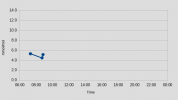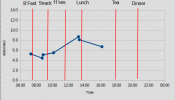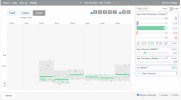Essex
Well-Known Member
- Relationship to Diabetes
- Type 2
This is better
"Continuous Glucose Profiles in Healthy Subjects under Everyday Life Conditions and after Different Meals"
Fig 2: Mean continuous IG trace obtained in healthy volunteers under everyday life conditions by means of the microdialysis technique. Mean interstitial glucose trace ± 2 SD (corresponding to the 95% range), n = 21; Cap. BG: capillary blood glucose values, used for calibration of the continuous glucose monitoring device.
Divide by 18 to get mmol/mol from mg/dl
(160 = 8.9, 140 = 7.8, 120 = 6.7, 100 = 5.6, 80 = 4.5, 60 = 3.4)

All study participants exhibited normal values for HbA1c (5.0 ± 0.2%), fasting concentrations of insulin (42.4 ± 16.0 pmol/liter), C-peptide (0.59 ± 0.17 nmol/liter), proinsulin (3.5 ± 2.3 pmol/liter), lipids (total cholesterol 4.6 ± 0.7 mmol/liter, high-density lipoprotein cholesterol 1.3 ± 0.3 mmol/liter, low-density lipoprotein cholesterol 2.9 ± 0.7 mmol/liter, triglycerides 0.8 ± 0.3 mmol/liter), creatinine (86.4 ± 12.6 µmol/liter), uric acid (272.2 ± 58.6 µmol/liter), liver enzymes, and hematology parameters.
"Continuous Glucose Profiles in Healthy Subjects under Everyday Life Conditions and after Different Meals"
Fig 2: Mean continuous IG trace obtained in healthy volunteers under everyday life conditions by means of the microdialysis technique. Mean interstitial glucose trace ± 2 SD (corresponding to the 95% range), n = 21; Cap. BG: capillary blood glucose values, used for calibration of the continuous glucose monitoring device.
Divide by 18 to get mmol/mol from mg/dl
(160 = 8.9, 140 = 7.8, 120 = 6.7, 100 = 5.6, 80 = 4.5, 60 = 3.4)

All study participants exhibited normal values for HbA1c (5.0 ± 0.2%), fasting concentrations of insulin (42.4 ± 16.0 pmol/liter), C-peptide (0.59 ± 0.17 nmol/liter), proinsulin (3.5 ± 2.3 pmol/liter), lipids (total cholesterol 4.6 ± 0.7 mmol/liter, high-density lipoprotein cholesterol 1.3 ± 0.3 mmol/liter, low-density lipoprotein cholesterol 2.9 ± 0.7 mmol/liter, triglycerides 0.8 ± 0.3 mmol/liter), creatinine (86.4 ± 12.6 µmol/liter), uric acid (272.2 ± 58.6 µmol/liter), liver enzymes, and hematology parameters.
Last edited:




